Bio 669 stuvia 2024 - Study guides, Class notes & Summaries
Looking for the best study guides, study notes and summaries about Bio 669 stuvia 2024? On this page you'll find 22 study documents about Bio 669 stuvia 2024.
Page 2 out of 22 results
Sort by
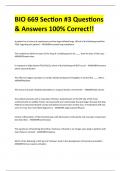
-
BIO 669 Section #3 Questions & Answers 100% Correct!!
- Exam (elaborations) • 10 pages • 2024
-
- $12.49
- + learn more
A patient has a history of emphysema and has hyperinflated lungs. Which of the following would be TRUE regarding this patient? - ANSWERIncreased lung compliance The compliance within the apex of the lung of a standing person be ____ than the base of the lung - ANSWERGreater than In response to high alveolar PO2 (PaO2), which of the following will NOT occur? - ANSWERPulmonary artery vasoconstriction The effect of oxygen saturation on carbon dioxide binding to hemoglobin is termed the ___...
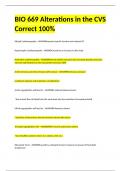
-
BIO 669 Alterations in the CVS Correct 100%
- Exam (elaborations) • 6 pages • 2024
-
- $11.99
- + learn more
Dilated Cardiomyopathy - ANSWERImpaired systolic function and reduced EF Hypertrophic Cardiomyopathy - ANSWERCaused by an increase in after load Restrictive Cardiomyopathy - ANSWERNormal systolic pressures but increased diastolic pressures (normal wall thickness by the myocardium becomes stiff)
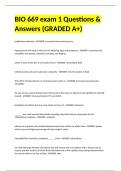
-
BIO 669 exam 1 Questions & Answers (GRADED A+)
- Exam (elaborations) • 7 pages • 2024
-
- $12.49
- + learn more
papilledema indicates - ANSWER increased intercranial pressure hypocalcemia will result in which of the following signs and symptoms - ANSWER neuromuscular excitability and spasms, intestinal cramping, and tingling where is most of the Na+ in our bodies found - ANSWER extracellular fluid Colloid osmotic pressure is pressure created by - ANSWER only the protein in fluid Thre effect of hypocalcemia on neuromuscular system is - ANSWER increased neuromuscular excitability the law...
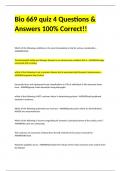
-
Bio 669 quiz 4 Questions & Answers 100% Correct!!
- Exam (elaborations) • 7 pages • 2024
-
- $12.49
- + learn more
Which of the following conditions is the most immediately at risk for serious complication - ANSWERSTEMI Thromboangiitis obliterans (Buerger disease) is an autoimmune condition that is - ANSWERstrongly associated with smoking which of the following is not a systemic disease that is associated with Reynaud's phenomenon - ANSWERcongestive heart failure rheumatic fever and subsequent heart complications in 10% of individuals is left untreated arises from - ANSWERgroup A beta hemolytic str...
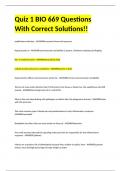
-
Quiz 1 BIO 669 Questions With Correct Solutions!!
- Exam (elaborations) • 4 pages • 2024
-
- $11.99
- + learn more
papiliedema indicates - ANSWERincreased intracranial pressure Hypocalcemia w - ANSWERneuromuscular excitability & spasms, intestinal cramping and tingling Na+ is mostly found in - ANSWERextracellular fluid Colloid osmotic pressure is created by - ANSWERprotein in
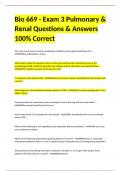
-
Bio 669 - Exam 3 Pulmonary & Renal Questions & Answers 100% Correct
- Exam (elaborations) • 6 pages • 2024
-
- $12.49
- + learn more
The main neural control central coordinating ventilation during quiet breathing is the - ANSWERDorsal Respiratory Group What helps to keep the expansion forces of the chest wall and the contracting forces of the alveoli/lungs linked so that the lung does not collapse and the chest does not expand further: - ANSWERThe negative pressure of the pleural cavity In response to low alveolar PO2 - ANSWERVascular smooth muscle controlling flow that alveolus will constrict What happens to the fun...
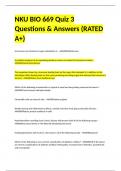
-
NKU BIO 669 Quiz 3 Questions & Answers (RATED A+)
- Exam (elaborations) • 5 pages • 2024
-
- $11.99
- + learn more
A hormone not involved in sugar metabolism is: - ANSWERAldosterone A possible symptom of an expanding pituitary tumor not related to hormones include: - ANSWERVisual disturbances The regulation shown by a hormone feeding back on the organ that released it, in addition to the physiologic effect feeding back on that same producing/secreting organ that released the hormone is termed: - ANSWERUltra short feedback loop Which of the following characteristics is typical of rapid and long lasti...
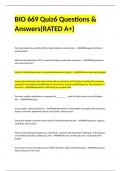
-
BIO 669 Quiz6 Questions & Answers(RATED A+)
- Exam (elaborations) • 4 pages • 2024
-
- $11.99
- + learn more
The renal blood flow and this GFR are kept relatively consistent by: - ANSWERMyogenic (intrinsic) autoregulation Which of the following is NOT a consistent finding in nephrotic syndrome? - ANSWERHypertension and vasoconstriction Which of the following does not stimulate aldosterone release? - ANSWERArterial natriuretic peptide Assume that fluid enters the distal tubule with an osmolarity of 100 mOsm, and that the maximum osmolarity of medullary interstitial fluid is 1100 mOsm. As plasma...
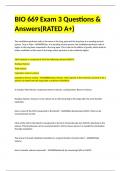
-
BIO 669 Exam 3 Questions & Answers(RATED A+)
- Exam (elaborations) • 4 pages • 2024
-
- $12.19
- + learn more
The ventilation-perfusion ratio is the same in the lung apex and the lung base in a standing normal person. True or False - ANSWERFalse. In a standing normal person, the ventilation-perfusion ratio is higher in the lung base compared to the lung apex. This is due to the effects of gravity, which leads to better ventilation at the base of the lungs where perfusion is also relatively higher. Vital Capacity is comprised of all of the following volumes EXCEPT: Residual Volume Tidal Volume Ins...
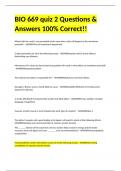
-
BIO 669 quiz 2 Questions & Answers 100% Correct!!
- Exam (elaborations) • 4 pages • 2024
-
- $12.49
- + learn more
When both Na+ and K+ are permeable at the same time, what will happen to the membrane potential? - ANSWERThe cell membrane depolarized Graded potentials are all of the following except: - ANSWERImpulses which travel without diminishing over distance Movement of K+ down its electrochemical gradient will result in what effect on membrane potential? - ANSWERHyperpoloarization

$6.50 for your textbook summary multiplied by 100 fellow students... Do the math: that's a lot of money! Don't be a thief of your own wallet and start uploading yours now. Discover all about earning on Stuvia


